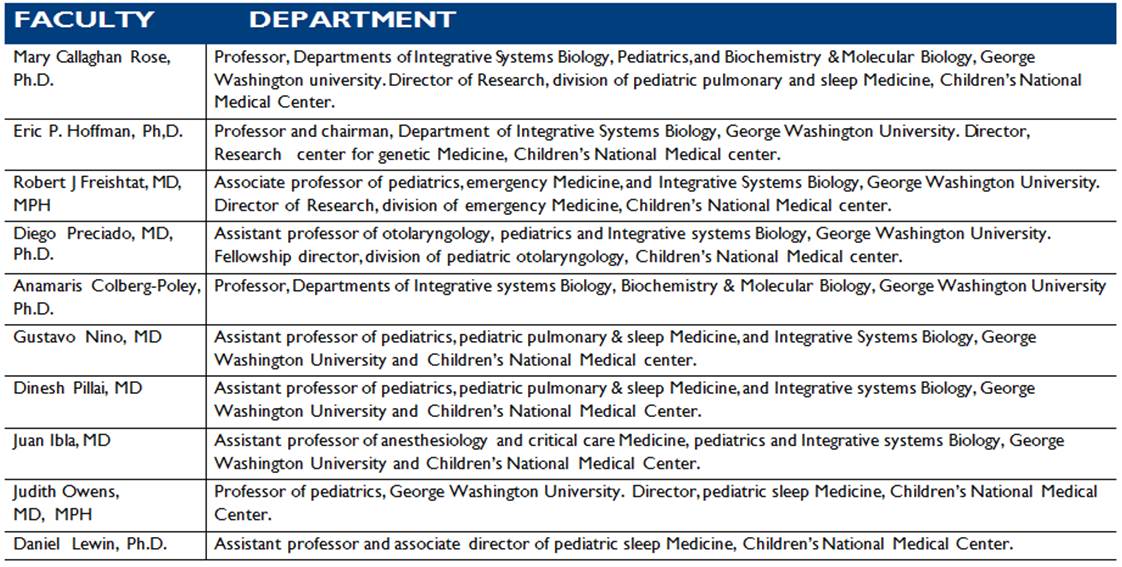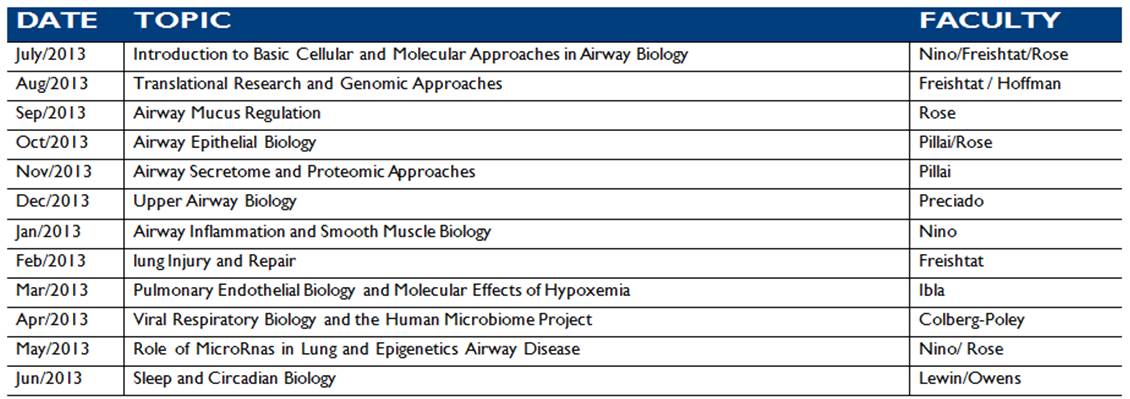Children’s National Medical Center
Washington, DC
Program Description
The Pediatric Pulmonary Fellowship at Children’s National Medical Center is a three-year ACG ME accredited program that trains individuals to become board-certified pediatric pulmonologists. The program consists of 16 months of clinical training with the rest of time devoted to research activities. Our presented innovative approach is a Lung and Airway Biology curriculum, which provides instruction in cellular & molecular biology, genomics and proteomics of the respiratory system in a format tailored for clinical trainees.
Type of Program
Pediatric Pulmonary
Number of Fellows in Program
6
Submitter(s) of Abstract
Geovanny F. Perez, MD
BACKGROUND
Pediatric Pulmonary training programs have two well-defined parallel components: clinical training and project-oriented research activities. The increasing need to translate basic science findings to clinical applications has motivated our Pediatric Pulmonary Fellowship program at Children’s National Medical Center (CNMC) in Washington, D.C. to add a third academic component, a Lung and Airway Biology Curriculum, to supplement our educational format, which consists of lectures tailored for clinical trainees. The new curriculum provides basic instruction in cellular and molecular biology, as well as genomics and proteomics, focused on the respiratory system. This innovative training strategy aims to develop a translational educational environment for the next generation of pediatric pulmonologists. At the same time, it provides a clinical view for research faculty, Ph.D. candidates and post-doctoral scholars at George Washington University (GWU). The Lung and Airway Biology curriculum is a multi-disciplinary effort of Dr. Iman Sami, M.D. (Fellowship Program Director), Dr. Mary Rose Ph.D. (Research Director Pediatric Pulmonary Division), Dr. Gustavo Nino, M.D. (Curriculum Coordinator) and a group of faculty (Table 1) conducting lung and airway biology research in the Children’s Research institute (CRI) at CNMC and the Department of Integrative Systems Biology (ISB) at GWU.
EDUCATIONAL STRATEGY
The overall goal of the Lung and Airway Biology Curriculum is to connect the clinical and research tracks during pediatric pulmonary fellowship training with translational basic science education. Rather than developing expertise in a specific area, which is best attained with a mentored research project, this curriculum intends to give a practical overview of basic sciences to facilitate the generation of translational approaches by clinical trainees. This educational program also aims to generate direct interactions between clinicians and scientists in CNMC/CRI and GWU/ISB, which may lead to productive research collaborations.
IMPLEMENTATION
The curriculum includes mandatory core didactic sessions in Lung and Airway Biology (once a month on Friday at 8am-9:30 am) and a weekly research lectures attended by fellows during their research time (Mondays at 8:45am-9:45am) with the Airway Biology group at CNMC/CRI and GWU/ISB. Table 2 illustrates the proposed core lecture series and speakers for 2013. The Lung and Airway Biology academic component is independent of other clinical and research educational activities of our fellowship program. Fellows are still required to attend regular lectures that cover clinical and physiology topics. They also identify a mentor/project and a scholarship oversight committee (SOC) that will guide research activities during fellowship.
OUTCOMES
The integration of the Lung and Airway Biology Curriculum to our pediatric pulmonary fellowship program is still in the early stages. In 2009 the Airway Biology group at CNMC/CRI and GWU/ISB invited pulmonary fellows to attend weekly meetings during research time. This group has also provided monthly lecture series on Fridays allowing a connection between clinicians and airway biology researchers. As a result, a more structured Lung and Airway Biology core lecture series has been developed for 2013 (Table 1). Despite its novelty, the integration of airway biology scientists into our pediatric pulmonary fellowship program has already produced positive outcomes including a significant increase in the number of ATS abstracts submitted by fellows in the last 18 months (Fig 1), which we anticipate will result in publications. Many of these projects use translational research approaches such as genomic, proteomic and phenotypical analysis of human data. We expect research productivity of fellows will increase further next year with the commencement of the Lung and Airway Biology core curriculum.
Table 1. Faculty
LUNG AND AIRWAY BIOLOGY CURRICULUM 2013
Table 2. Curriculum




